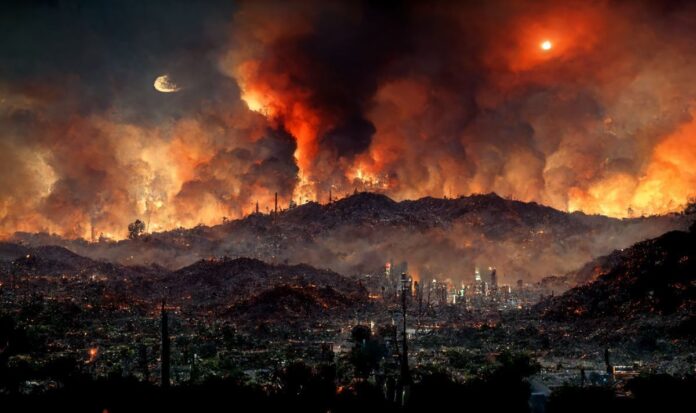An artificial intelligence (AI) has created images of how the world might look in the year 2100 if we achieve the goal of net zero emissions – and if we continue releasing climate change-driving greenhouse gases at our present, ‘business-as-usual’ rate. The neural network, ‘Midjourney’, was tasked by energy experts at price comparison service Uswitch to imagine possibles futures of various cities – from London to Los Angeles – based on data from the most recent Intergovernmental Panel on Climate Change report. In the worst-case scenarios, the AI imagined extreme pollution in London and Tokyo, rampant wildfires in Los Angeles and floods in Amsterdam and Rio de Janeiro.As USwitch explains, ‘Recent Summers in Britain’s capital have become noticeably hotter and drier. By the middle of this century, an average summer in London could be a fifth drier and an average summer’s day could be 3C [5.4F] warmer.’After London’s temperatures recently surpassed 41C [105.8F] in the summer of 2022, heat waves are more likely to happen and could be even hotter.’Midjourney imagined the worst case scenario for London’s future as foggy and grey, reflecting how pollution and air quality are real-life issues for health in the capital.However, the AI predicts a much greener and brighter future if net zero might be achieved by 2050 – a success that USwitch says will require UK citizens to do their bit by, for example, cutting down on meat, limiting car journeys and switching to public transport. In the worst-case emissions scenario, the AI imagined Los Angeles beset by rampant wildfires (Image: USwitch / Midjourney) Pictured: The AI’s art of London 2100 in the worst-case emissions scenario (Image: USwitch / Midjourney) Pictured: The AI’s art of London 2100 in the net zero emissions scenario (Image: USwitch / Midjourney)The Big Apple, USwitch said – like most business hubs – ‘has been heavily polluted by emissions from the daily commute.’The AI images predict that if things are to continue and if we do not achieve Net Zero by 2050, then New York’s leafy Central Park could end up in a permanent drought state.”However, the visualisation of what the city could look like in 2100 if the world reaches Net Zero status is much more appealing.’As cities rely on their green spaces to combat high carbon emissions, it would be great to see a city park thriving like this in the next few decades.’READ MORE: UK areas at risk of going ‘underwater’ outlined in terrifying map Pictured: The AI’s art of the New York City of 2100 in the worst-case emissions scenario (Image: USwitch / Midjourney) Pictured: The AI’s art of the New York City of 2100 in the net zero emissions scenario (Image: USwitch / Midjourney)In 2019, the Toronto city council unanimously voted to declare a climate emergency, and since then the metropolis has set itself one of North America’s most ambitious Net Zero timescales – aiming to achieve the state by the year 2040.USwitch said: ‘Climate change is expected to make Toronto’s weather hotter, wetter, and more extreme in the years to come.’So to get to Net Zero by the 2040 goal, fossil fuels used in Canadian homes, corporations and vehicles are being completely phased out over the next two decades.’If this does not happen, [the] AI anticipates a dark and gloomy Toronto that has extremely visible pollution affecting the city’s skyline.’However, if the city council and the people of Canada contribute to making these changes then the image on the right could resemble a more positive outlook.’DON’T MISS:Earth’s ‘distress signal’ laid bare as dangerous heat levels broken [ANALYSIS]Octopus Energy shares boiler hack saving customers £112 a year [INSIGHT]UK firm to build new battery site to make electric vehicles cheaper [REPORT] Pictured: The AI’s art of Toronto 2100 in the worst-case emissions scenario (Image: USwitch / Midjourney) Pictured: The AI’s art of Toronto 2100 in the net zero emissions scenario (Image: USwitch / Midjourney)Uswitch’s Ben Gallizzi said: ‘It is important to visualise how the world could look in the next few decades if we fail to start making changes now.’And there are some simple ways we can try and reduce our carbon footprint to help prevent things such as species going extinct, wildfires ruining ecosystems and rising sea levels.’These small changes could be as simple as reducing the number of days we commute by car, reassessing the type and amount of food we eat or making our homes more energy efficient.’If countries around the world do not start to change their habits, then the repercussions could lead to many places looking unrecognisable.’
Stark images show world’s cities by 2100 embroiled in fire and floods
Sourceexpress.co.uk
RELATED ARTICLES


